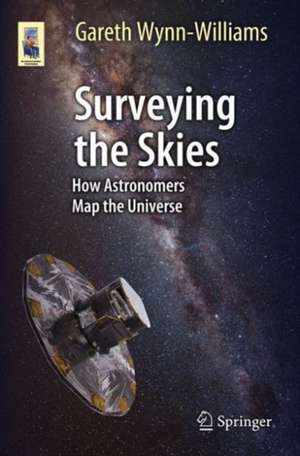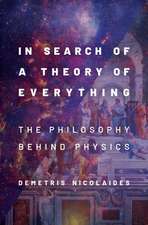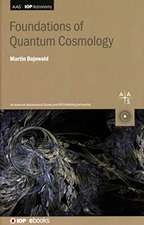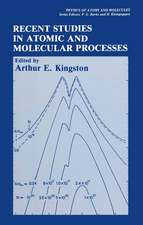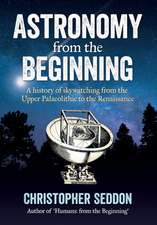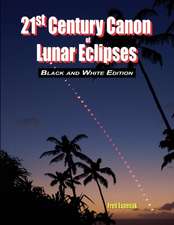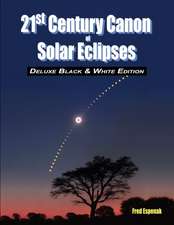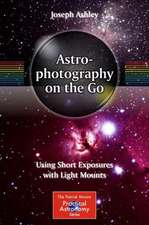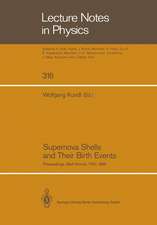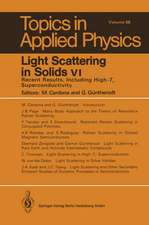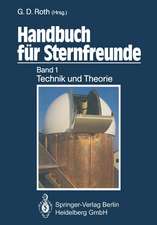Surveying the Skies: How Astronomers Map the Universe: Astronomers' Universe
Autor Gareth Wynn-Williamsen Limba Engleză Paperback – 27 iun 2016
Since the time of Galileo, astronomy has been driven by technological innovation. With each major advance has come the opportunity and enthusiasm to survey the sky in a way that was not possible before. It is these surveys of discovery that are the subject of this book.
In the first few chapters the author discusses what astronomers learned from visible-light surveys, first with the naked eye, then using telescopes in the seventeenth century, and photography in the nineteenth century. He then moves to the second half of the twentieth century when the skies started to be swept by radio, infrared, ultraviolet, x-ray and gamma ray telescopes, many of which had to be flown in satellites above the Earth’s atmosphere. These surveys led to the discovery of pulsars, quasars, molecular clouds, protostars, bursters, and black holes.
He then returns to Earth to describe several currently active large-scale projects that methodically collect images, photometry and spectra that are then stored in vast publicly-accessible databases. Dr. Wynn-Williams also describes several recent “microsurveys” – detailed studies of small patches of sky that have led to major advances in our understanding of cosmology and exoplanets.
Din seria Astronomers' Universe
-
 Preț: 210.44 lei
Preț: 210.44 lei -
 Preț: 207.15 lei
Preț: 207.15 lei -
 Preț: 195.53 lei
Preț: 195.53 lei -
 Preț: 254.90 lei
Preț: 254.90 lei -
 Preț: 259.27 lei
Preț: 259.27 lei -
 Preț: 212.88 lei
Preț: 212.88 lei -
 Preț: 256.41 lei
Preț: 256.41 lei -
 Preț: 264.35 lei
Preț: 264.35 lei -
 Preț: 259.08 lei
Preț: 259.08 lei -
 Preț: 227.61 lei
Preț: 227.61 lei -
 Preț: 277.98 lei
Preț: 277.98 lei -
 Preț: 305.70 lei
Preț: 305.70 lei -
 Preț: 253.11 lei
Preț: 253.11 lei -
 Preț: 216.60 lei
Preț: 216.60 lei -
 Preț: 272.24 lei
Preț: 272.24 lei -
 Preț: 330.75 lei
Preț: 330.75 lei -
 Preț: 179.00 lei
Preț: 179.00 lei -
 Preț: 289.83 lei
Preț: 289.83 lei -
 Preț: 160.03 lei
Preț: 160.03 lei -
 Preț: 200.80 lei
Preț: 200.80 lei -
 Preț: 255.97 lei
Preț: 255.97 lei -
 Preț: 242.58 lei
Preț: 242.58 lei -
 Preț: 262.55 lei
Preț: 262.55 lei -
 Preț: 257.08 lei
Preț: 257.08 lei -
 Preț: 187.82 lei
Preț: 187.82 lei -
 Preț: 225.19 lei
Preț: 225.19 lei -
 Preț: 207.64 lei
Preț: 207.64 lei -
 Preț: 104.35 lei
Preț: 104.35 lei -
 Preț: 188.94 lei
Preț: 188.94 lei -
 Preț: 270.49 lei
Preț: 270.49 lei -
 Preț: 212.01 lei
Preț: 212.01 lei -
 Preț: 169.08 lei
Preț: 169.08 lei -
 Preț: 210.01 lei
Preț: 210.01 lei -
 Preț: 208.26 lei
Preț: 208.26 lei -
 Preț: 253.98 lei
Preț: 253.98 lei -
 Preț: 180.12 lei
Preț: 180.12 lei -
 Preț: 254.90 lei
Preț: 254.90 lei -
 Preț: 247.82 lei
Preț: 247.82 lei -
 Preț: 207.39 lei
Preț: 207.39 lei -
 Preț: 208.70 lei
Preț: 208.70 lei -
 Preț: 214.86 lei
Preț: 214.86 lei -
 Preț: 188.94 lei
Preț: 188.94 lei -
 Preț: 194.65 lei
Preț: 194.65 lei -
 Preț: 277.34 lei
Preț: 277.34 lei -
 Preț: 187.15 lei
Preț: 187.15 lei -
 Preț: 210.93 lei
Preț: 210.93 lei -
 Preț: 212.01 lei
Preț: 212.01 lei
Preț: 254.34 lei
Nou
Puncte Express: 382
Preț estimativ în valută:
48.67€ • 50.53$ • 40.59£
48.67€ • 50.53$ • 40.59£
Carte tipărită la comandă
Livrare economică 21-27 martie
Preluare comenzi: 021 569.72.76
Specificații
ISBN-13: 9783319285085
ISBN-10: 3319285084
Pagini: 250
Ilustrații: XI, 187 p. 129 illus., 89 illus. in color.
Dimensiuni: 155 x 235 x 11 mm
Greutate: 0.39 kg
Ediția:1st ed. 2016
Editura: Springer International Publishing
Colecția Springer
Seria Astronomers' Universe
Locul publicării:Cham, Switzerland
ISBN-10: 3319285084
Pagini: 250
Ilustrații: XI, 187 p. 129 illus., 89 illus. in color.
Dimensiuni: 155 x 235 x 11 mm
Greutate: 0.39 kg
Ediția:1st ed. 2016
Editura: Springer International Publishing
Colecția Springer
Seria Astronomers' Universe
Locul publicării:Cham, Switzerland
Public țintă
Popular/generalCuprins
The Five Ages of Astronomy.- The Naked Eye Era.- The Telescope Era.- The Photography Era.- Radio Surveys.- Near-Infrared Surveys.- Far-infrared Surveys.- Ultraviolet Surveys.- X-ray Surveys - Gamma Ray Surveys.- The Gigasurvey Era.- Special Surveys.
Recenzii
Selected by Choice magazine as an Outstanding Academic Title for 2017
“This work is a masterful summary of the history of surveys at all wavelengths in astronomy, detailing the major advances supported by modern technology. … The book, intended for the lay reader, is extremely well written and highly recommended. Summing Up: Highly recommended. All readers.” (D. E. Hogg, Choice, Vol. 54 (5), January, 2017)
“This book is all about the history of sky surveys. … This book is published in Springer’s Astronomers’ Universe series, which delivers an armchair experience to active amateur astronomers. Fair enough. However, it is suitable, and deserves a much wider readership, because it is such a handy history of how the heavens have been harvested. … It is a good introduction for graduates who are considering doctoral research in observational astronomy, and an essential reference book for libraries.” (Simon Mitton, The Observatory, Vol. 137 (1256), February, 2017)
“This work is a masterful summary of the history of surveys at all wavelengths in astronomy, detailing the major advances supported by modern technology. … The book, intended for the lay reader, is extremely well written and highly recommended. Summing Up: Highly recommended. All readers.” (D. E. Hogg, Choice, Vol. 54 (5), January, 2017)
“This book is all about the history of sky surveys. … This book is published in Springer’s Astronomers’ Universe series, which delivers an armchair experience to active amateur astronomers. Fair enough. However, it is suitable, and deserves a much wider readership, because it is such a handy history of how the heavens have been harvested. … It is a good introduction for graduates who are considering doctoral research in observational astronomy, and an essential reference book for libraries.” (Simon Mitton, The Observatory, Vol. 137 (1256), February, 2017)
Notă biografică
Born in London, Gareth Wynn-Williams received his BA and PhD degrees in physics from the University of Cambridge, specializing in radio astronomy. He then switched wavelength to spend two years doing postdoctoral research with the infrared astronomy group at Caltech. He held a faculty teaching position at the Cavendish Laboratory in Cambridge University for five years before taking up a professorship at the University of Hawaii in 1978, where he remained until he retired in 2012. His research focus throughout his career has been interstellar matter in the Milky Way and in other galaxies.
Textul de pe ultima copertă
Since the time of Galileo, astronomy has been driven by technological innovation. With each major advance has come the opportunity and enthusiasm to survey the sky in a way that was not possible before. It is these surveys of discovery that are the subject of this book.
In the first few chapters the author discusses what astronomers learned from visible-light surveys, first with the naked eye, then using telescopes in the seventeenth century, and photography in the nineteenth century. He then moves to the second half of the twentieth century when the skies started to be swept by radio, infrared, ultraviolet, x-ray and gamma ray telescopes, many of which had to be flown in satellites above the Earth’s atmosphere. These surveys led to the discovery of pulsars, quasars, molecular clouds, protostars, bursters, and black holes.
He then returns to Earth to describe several currently active large-scale projects that methodically collect images, photometry and spectra that are then stored in vast publicly-accessible databases. Dr. Wynn-Williams also describes several recent “microsurveys” – detailed studies of small patches of sky that have led to major advances in our understanding of cosmology and exoplanets.
Caracteristici
Understand the technology breakthroughs that led directly to major discoveries Discover how the sky would look if you had infrared or X-ray sensitive eyes! Includes supplementary material: sn.pub/extras
